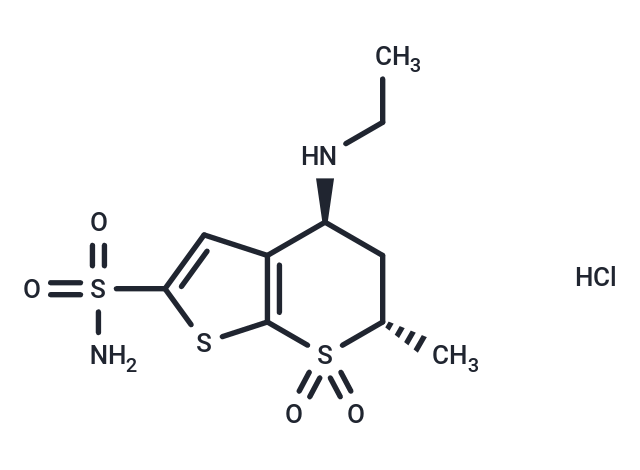Shopping Cart
- Remove All
 Your shopping cart is currently empty
Your shopping cart is currently empty
Dorzolamide hydrochloride (MK507 hydrochloride) is the hydrochloride salt form of dorzolamide, an inhibitor of carbonic anhydrase, a zinc-containing enzyme that catalyzes the rapid conversion of carbon dioxide and water into carbonic acid, protons and bicarbonate ions. Distributed throughout many cells and tissues, various carbonic anhydrases play important roles in mineral and metabolic homeostasis.

| Pack Size | Price | Availability | Quantity |
|---|---|---|---|
| 25 mg | $35 | In Stock | |
| 50 mg | $48 | In Stock | |
| 100 mg | $68 | In Stock | |
| 500 mg | $228 | In Stock | |
| 1 g | $337 | In Stock |
| Description | Dorzolamide hydrochloride (MK507 hydrochloride) is the hydrochloride salt form of dorzolamide, an inhibitor of carbonic anhydrase, a zinc-containing enzyme that catalyzes the rapid conversion of carbon dioxide and water into carbonic acid, protons and bicarbonate ions. Distributed throughout many cells and tissues, various carbonic anhydrases play important roles in mineral and metabolic homeostasis. |
| Targets&IC50 | CA I:6000 nM(Ki), CA II:1.9 nM(Ki), CA IV:31 nM(Ki) |
| In vitro | In rabbits, Dorzolamide hydrochloride significantly reduces intraocular pressure (IOP) and is effective at night as well. Dorzolamide substantially decreases IOP in glaucoma-afflicted monkeys by 22%, 30%, and 37%. The combination of Dorzolamide (administered topically to the eye for 1 to 5 days) and oral methazolamide (administered from day 3 to day 5) significantly lower IOP, with this effect persisting on days 1, 3, and 5. Compared to the regimen of twice-daily oral methazolamide and 2% Dorzolamide, applying Dorzolamide (2%) topically three times a day achieves a similar reduction in IOP. |
| In vivo | Dorzolamide induces dilation of retinal blood vessels through three distinct mechanisms that directly cause precontraction, independent of extracellular pH changes. It acts as a potent inhibitor of carbonic anhydrase (CA) II, penetrating the sclera and cornea to reach the ciliary processes and reduce the formation of HCO3 and aqueous humor. |
| Synonyms | MK507 hydrochloride, MK-507 (L-671152) HCl, L671152 hydrochloride, Dorzolamide HCl |
| Molecular Weight | 360.9 |
| Formula | C10H17ClN2O4S3 |
| Cas No. | 130693-82-2 |
| Smiles | c12c([C@H](C[C@@H](S1(=O)=O)C)NCC)cc(s2)S(=O)(=O)N.Cl |
| Relative Density. | 1.53 g/cm3 |
| Storage | Powder: -20°C for 3 years | In solvent: -80°C for 1 year | Shipping with blue ice/Shipping at ambient temperature. | ||||||||||||||||||||||||||||||
| Solubility Information | H2O: 13.3 mg/mL (36.85 mM), Sonication is recommended. DMSO: 1 mg/mL (2.77 mM), Sonication is recommended. | ||||||||||||||||||||||||||||||
Solution Preparation Table | |||||||||||||||||||||||||||||||
DMSO/H2O
H2O
| |||||||||||||||||||||||||||||||

Copyright © 2015-2025 TargetMol Chemicals Inc. All Rights Reserved.